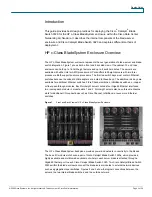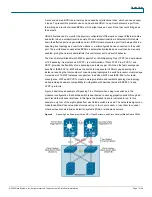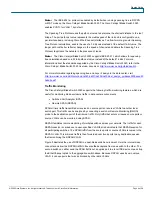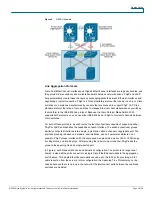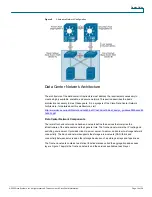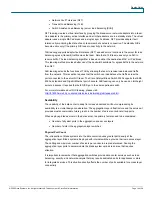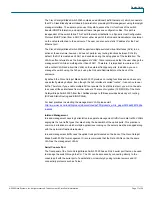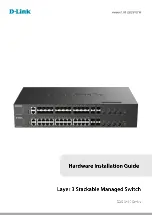
Design Guide
© 2008 Cisco Systems, Inc. All rights reserved. This document is Cisco Public Information.
Page 8 of 28
Note:
The IEEE 802.1w protocol is enabled by default when running spanning tree in RPVST+
or MST mode on the Cisco Catalyst Blade Switch 3020. The Cisco Catalyst Blade Switch 3020
enables PVST+ for VLAN 1 by default.
The Spanning Tree Protocol uses the path cost value to determine the shortest distance to the root
bridge. The port path cost value represents the media speed of the link and is configurable on a
per-interface basis, including Cisco EtherChannel interfaces. To allow for more granular Spanning
Tree Protocol calculations, enable the use of a 32-bit value instead of the default 16-bit value. The
longer path cost better reflects changes in the speed of channels and allows the Spanning Tree
Protocol to optimize the network in the presence of loops.
Note:
The Cisco Catalyst Blade Switch 3020 supports IEEE 802.1t, which allows for spanning-
tree calculations based on a 32-bit path cost value instead of the default 16 bits. For more
information about the standards supported by the Cisco Catalyst Blade Switch 3020, refer to the
Cisco Catalyst Blade Switch 3020 Overview document:
http://www.cisco.com/go/bladeswitch
.
For more information regarding spanning tree and Layer 2 design in the data center, visit:
http://www.cisco.com/en/US/solutions/ns340/ns517/ns224/ns304/net_design_guidance0900aecd80
0e4d2e.pdf
.
Traffic Monitoring
The Cisco Catalyst Blade Switch 3020 supports the following traffic-monitoring features, which are
useful for monitoring blade-enclosure traffic in data center environments:
●
Switched Port Analyzer (SPAN)
●
Remote SPAN (RSPAN)
SPAN mirrors traffic transmitted or received on source ports or source VLANs to another local
switch port. This traffic can be analyzed by connecting a switch or Remote Monitoring (RMON)
probe to the destination port of the mirrored traffic. Only traffic that enters or leaves source ports or
source VLANs can be monitored using SPAN.
RSPAN facilitates remote monitoring of multiple switches across your network. The traffic for each
RSPAN session is carried over a user-specified VLAN that is dedicated to that RSPAN session for
all participating switches. The SPAN traffic from the source ports or source VLANs is copied to the
RSPAN VLAN. This mirrored traffic is then forwarded over trunk ports to any destination session
that is monitoring the RSPAN VLAN.
Figure 5 illustrates the use of RSPAN in a dual-blade switch environment. Here the internal cross-
connects can allow the RSPAN traffic to traverse the backplane from one switch to the other. The
second switch can either send the SPAN traffic out an uplink port to a local IDS device or pass it up
the EtherChannel uplink to the aggregation switch above. Because RSPAN uses its own unique
VLAN, it can use ports that may be blocked by other data VLANs.



